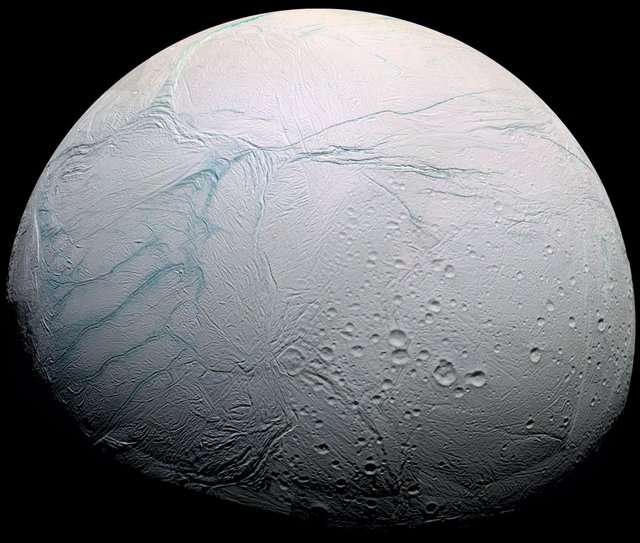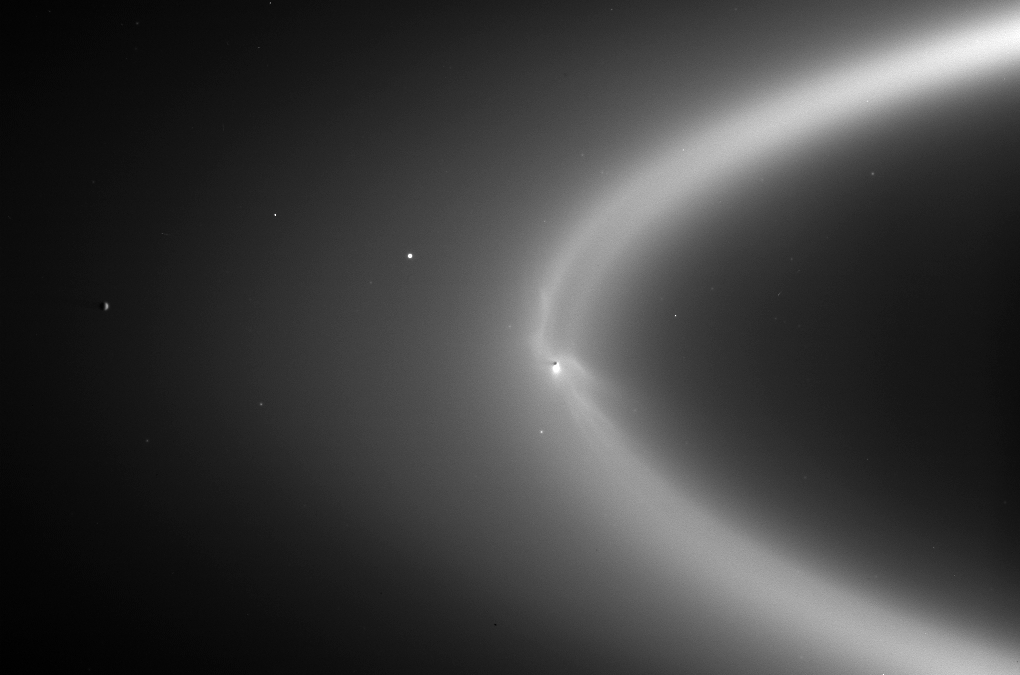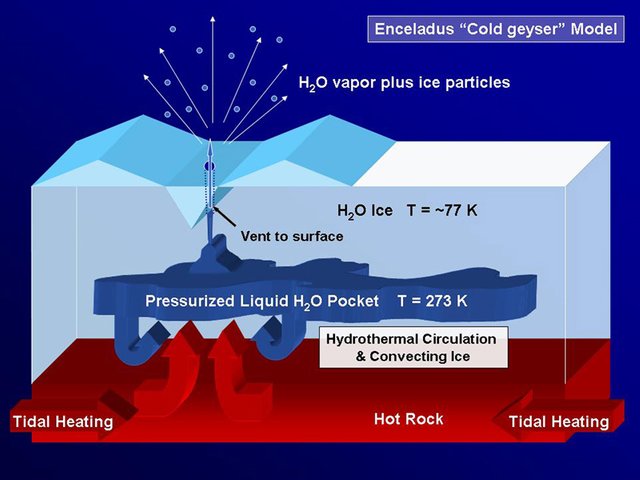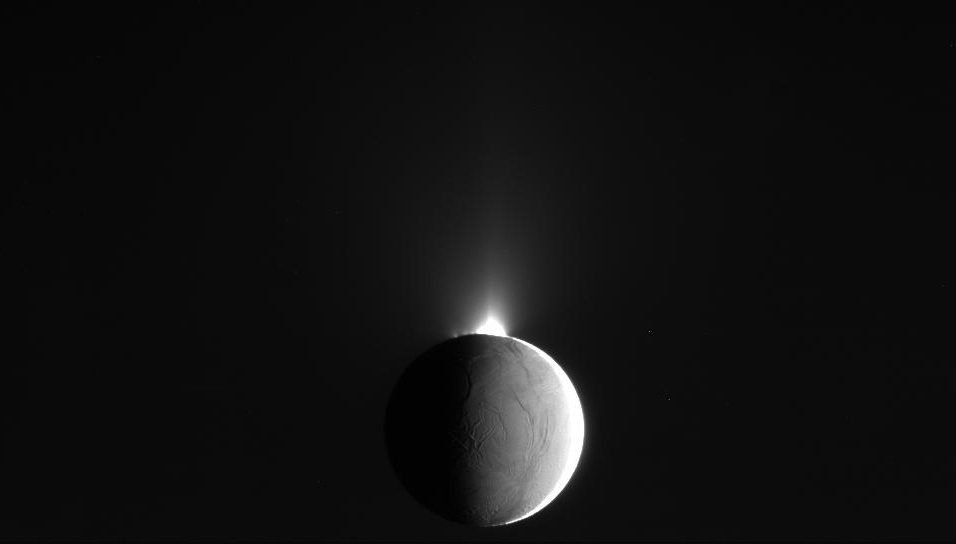Oddball Geological Features: Part 5 – The Cryovolcanoes of Enceladus
 Here lies Enceladus, an orbiting moon of Saturn. This beaut of a photo was taken by the Cassini Probe while on its official mission to take a closer look at Saturn and its other moon Titan. Note the fractures in the surface of the moon. [Image Source]
Here lies Enceladus, an orbiting moon of Saturn. This beaut of a photo was taken by the Cassini Probe while on its official mission to take a closer look at Saturn and its other moon Titan. Note the fractures in the surface of the moon. [Image Source]
Amongst all the terrestrial objects in our solar system, it’s the planetary satellites (moons) that orbit the major planets that, geologically speaking, I’m finding to be the most intriguing. This sentiment is largely based on the fact that there are so many of them to study! For example— Did you know Saturn has 53 confirmed moons? Jupiter has an even higher tally with a grand total of 63 confirmed moons! If you noticed the emphasis I’m putting on “confirmed,” it’s because astronomers are under the impression that more moons will in all likelihood be discovered. From a geological standpoint, the shear abundance of planetary satellites in our solar system would give geologists an incredible opportunity to better understand how our solar system formed billions of years ago. While many of these moons resemble a large asteroid, some of them have geological features that make them entirely unique to their counterparts.
One of the more interesting geological features that kept popping up through my research of the moons in the solar system were cryovolcanoes, which are also known as cryogeysers. Unlike your typical volcano that erupts molten rock, cryovolcanoes erupt volatiles such as water, ammonia and methane, which is commonly referred to as cryomagma. Examples of this type of volcano have been observed all over the solar system —Titan, Europa, Enceladus, Pluto, etc. — but that doesn’t make them any less intriguing. They’re actually one of the greatest mysteries in our solar system, mainly due to the fact the actual origin of them is theoretical. However, this did not stop scientists from giving the best educated guesses they could muster up.
 This image displays the icy plumes produced from the cryovolcanoes of Enceladus. The little black speck is the moon itself. This photo was captured by Cassini Probe when the Sun was behind Saturn, allowing the ice plumes to be seen. Eventually these plumes will be deposited into Saturn's E Ring, which is the source of the ring itself. [Image Source]
This image displays the icy plumes produced from the cryovolcanoes of Enceladus. The little black speck is the moon itself. This photo was captured by Cassini Probe when the Sun was behind Saturn, allowing the ice plumes to be seen. Eventually these plumes will be deposited into Saturn's E Ring, which is the source of the ring itself. [Image Source]
On Enceladus, which is an orbiting satellite of Saturn, cryovolcanoes are known to occur. What makes Enceladus so intriguing is the fact the color of the planet (white) is the byproduct of cryovolcanic eruptions. The whiteness of the moons surface also makes it one of the most reflective bodies in the solar system. Furthermore, the eruptions occurring on this moon also contribute to the formation of Saturn’s E Ring. When these cryovolcanoes erupt, liquid volatiles are dispensed into space. Due to the low surface temperature of Enceladus (−198 °C or −324 °F) and the cold vacuum of space, these liquids condense into a solid form, which then precipitate back down on the moon as snow. That’s right, space snow! However, because of the low gravitation pull of Enceladus, some of the volcanic ice plume escapes it’s gravity, which is then deposited as a ring around Saturn. The picture I provided above is an actual photo taken by the Cassini Probe, capturing this process taking place.
 This simplified diagram helps visualize the tidal friction that is occurring underneath Enceladus' icy surface. [Image Source]
This simplified diagram helps visualize the tidal friction that is occurring underneath Enceladus' icy surface. [Image Source]
So in the instance of Enceladus, what causes cryovolcanoes to occur? Considering most of this is entirely theoretical— Under the icy surface of the southern pole of the moon, lies a salty subsurface ocean. While there are numerous theories as to why this subsurface ocean exists, it is generally thought that the formation occurred due to a mixture of radioactive decay in the moons core (produces heat) and tidal heating. Similar to the tides on Earth caused from the gravitational tug of the Moon, Enceladus deals with the gravitational pull of Saturn. As the moon orbits Saturn eccentrically, gravitational stresses are applied to the fragmented porous core and subsurface ocean. This is commonly referred to as tidal friction.
Essentially, orbital energy caused by gravitation stresses creates a convection of sorts in the subsurface ocean, allowing the liquid and hot rock in the core to interact with one another. As a result, heated pressurized liquid is forced out of the moons icy crust, which then condenses in the cold surroundings to create snow. Furthermore, there are noticeable “tiger stripes” on Enceladus’ south pole, which lead scientists to believe they are the product of enhanced heat flux and in all likelihood the source of the cryovolcanoes. It should also be noted, because this moon is believed to have liquid water and a heating source, this would be a prime location for amino acids to form a.k.a. life.
 Yet another amazing photo taken by the Cassini Probe that shows the cryovolcanic eruptions taking place on Encedalus. [Image Source]
Yet another amazing photo taken by the Cassini Probe that shows the cryovolcanic eruptions taking place on Encedalus. [Image Source]
Given the numerous examples of other cryovolcanoes in the solar system, I chose Enceladus because I loved the fact it’s the source of Saturn’s E Ring, holds the potential for life and is an actual snow planet. Another moon that exhibits very similar properties as Enceladus, is the orbiting moon of Jupiter, Europa. In the future of space travel, I believe we will one day land on these planetary satellites to collect more reliable data. Perhaps, one day we will even put a submarine under the icy surfaces of Enceladus or Europa. While it is always fascinating to wonder if we’ll ever make it out of our solar system to the next closest star system (Alpha Centauri), I’m fairly certain our home system will provide enough scientific evidence for us to have a better understanding of how planets, life and other processes take place throughout the universe. All being said, I think it goes without saying that the cryovolcanoes of our solar system earned the title of “oddball geological feature.”
If you enjoyed reading this post, be sure to give me a follow and check out the rest of my blog. Overall, my blog consists of scientific topics dealing with geology, meteorology, food and history. The goal of this blog isn’t to earn money per se. While that is a nice benefit, I’m more interested in networking, learning, informing and helping the Steemit community grow to new heights. Thanks for all your support!
Oddball Geological Features Series:
Part 1 – The Chocolate Hills of Bohol
Part 2 – The Sailing Stones of the Playa
Part 3 – The Rainbow Mountains of China
Bibliography:
https://en.wikipedia.org/wiki/Cryovolcano
https://en.wikipedia.org/wiki/Enceladus#Tidal_heating
https://en.wikipedia.org/wiki/Europa
https://en.wikipedia.org/wiki/Tidal_heating
https://solarsystem.nasa.gov/planets/enceladus
Casual reading and studying
You received a 10.0% upvote since you are not yet a member of geopolis.
To read more about us and what we do, click here.
https://steemit.com/geopolis/@geopolis/geopolis-the-community-for-global-sciences-update-1
If you do not want us to upvote and comment on your posts concerning earth and earth sciences, please reply stop to this comment and we will no longer bother you with our love ❤️
Up-voted, re-steemed, and followed. Nice job.
Awesome breakdown! I had no idea that is what formed Saturn's rings. If the moon is ejecting this much matter, is it slowly draining it's supply? Will it eventually run out of material to erupt?
Thank you! The plumes from Enceladus only make up the E Ring, which isn't very pronounced compared to the others. While the rings do have an abundance of water ice and other rocky materials, they most likely formed from comets, asteroids and moons colliding with one another in Saturn's orbit.
As for the questions you asked— I'd imagine the cryovolcanoes on Enceladus would be active as long as tidal friction is occurring. I doubt the moon is emitting enough water ice to run out. Also, since some of the snow precipitates back onto the moon, it's possible there may be a cyclical process of some form occurring.
It would be interesting to see, once we actually get there, of course, the water cycle of Enceladus. If the underlying snow melts just enough to creep down through the fractures back into the subsurface ocean. Extremely fascinating.
@originalworks
The @OriginalWorks bot has determined this post by @keephy to be original material and upvoted it!
To call @OriginalWorks, simply reply to any post with @originalworks or !originalworks in your message!
The fact these moons aren't confirmed, but are so large, just emphasises how insanely far away they are. Great post! Thanks!
Hey there! Most of the moons are in fact confirmed, but astronomers aren't ruling out the possibility they may discover more. When I read how many moons orbit Saturn and Jupiter, I was pretty impressed.
Really cool and interesting stuff! I did know some aboout cryovolcanoes, but the way you explain everything is very clear and interesting to read. Thanks for sharing
I’m a geologist too man good to hear there are others on steemit